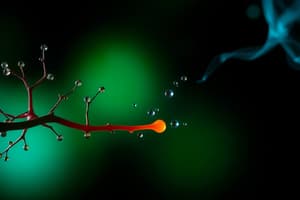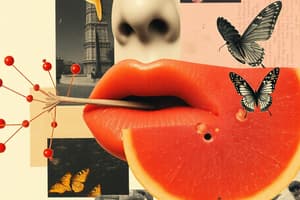Podcast
Questions and Answers
Where are taste buds primarily located on the tongue?
Where are taste buds primarily located on the tongue?
- Mainly on the dorsal surface (correct)
- Along the sides of the tongue
- On the ventral surface
- In the center of the tongue
What is the primary function of the olfactory neurons?
What is the primary function of the olfactory neurons?
- To detect chemicals in the air (correct)
- To detect light intensity
- To stimulate taste sensations
- To maintain balance
Which structure in the eye contains the photoreceptors?
Which structure in the eye contains the photoreceptors?
- Cornea
- Iris
- Lens
- Retina (correct)
Which cranial nerve is responsible for taste sensations from the posterior 1/3 of the tongue?
Which cranial nerve is responsible for taste sensations from the posterior 1/3 of the tongue?
What substance is contained within the posterior cavity of the eyeball?
What substance is contained within the posterior cavity of the eyeball?
Which part of the ear helps to equalize air pressure?
Which part of the ear helps to equalize air pressure?
What is the role of the pupillary reflex?
What is the role of the pupillary reflex?
What are the smallest bones in the human body found in the middle ear?
What are the smallest bones in the human body found in the middle ear?
What is the endocrine system made up of?
What is the endocrine system made up of?
What are hormones?
What are hormones?
Which hormones are lipid soluble and can be taken orally?
Which hormones are lipid soluble and can be taken orally?
All hormones can be taken orally because they are stable in the stomach.
All hormones can be taken orally because they are stable in the stomach.
What are target cells?
What are target cells?
What mechanism controls hormone secretion?
What mechanism controls hormone secretion?
What does the pituitary gland also called?
What does the pituitary gland also called?
What does growth hormone (GH) stimulate?
What does growth hormone (GH) stimulate?
What is hypersecretion of thyroid stimulating hormone (TSH) associated with?
What is hypersecretion of thyroid stimulating hormone (TSH) associated with?
Hyposecretion of antidiuretic hormone (ADH) causes excessive water loss in urine, also known as __________.
Hyposecretion of antidiuretic hormone (ADH) causes excessive water loss in urine, also known as __________.
Thyroxine (T4) and Triiodothyronine (T3) do not require iodine for their synthesis.
Thyroxine (T4) and Triiodothyronine (T3) do not require iodine for their synthesis.
Study Notes
Gustatory Sense (Taste)
- Taste buds are mainly located on the dorsal surface of the tongue in papillae structures.
- Chemo receptors react to chemicals in food and can detect four primary tastes: salt, sour, sweet, and bitter.
- Nerves from the anterior two-thirds of the tongue travel through the facial nerve (cranial nerve VII).
- Nerves from the posterior one-third of the tongue travel along the glossopharyngeal nerve (cranial nerve IX).
- The gustatory cortex is found in the parietal lobe of the brain.
Olfactory Sense (Smell)
- Olfactory neurons are concentrated in the superior region of the nasal cavity.
- Chemo receptors are activated by chemicals dissolved in liquid form.
- Afferent nerves run through the olfactory nerve (cranial nerve I) to the olfactory cortex, located in the temporal lobe.
Visual Sense (Sight)
- The eyeball consists of three layers (tunics): fibrous (outer), vascular (middle), and nervous (inner, retina).
- It has two cavities: the anterior cavity (contains aqueous humor) and the posterior cavity (contains gelatinous vitreous humor to maintain eye shape).
- The pupil is the opening in the center of the iris and can change size in response to light.
- Bright light causes pupil constriction, while dim light leads to dilation.
- Photoreceptors, namely rods and cones, are located in the retina and are responsible for visual impulse transmission.
- Visual impulses are sent via the optic nerve to the visual cortex in the occipital lobe.
Auditory Sense (Hearing) & Equilibrium
- The ear is divided into three parts: the external ear, middle ear, and inner ear.
- The external ear includes the auricle (pinna) and the external auditory canal.
- The middle ear begins at the tympanic membrane and connects to the Eustachian tube, which equalizes air pressure.
- The middle ear houses the auditory ossicles (malleus, incus, and stapes), the smallest bones in the body.
- The inner ear consists of the bony labyrinth (interconnecting chambers) and the membranous labyrinth (fluid-filled tubes within).
- The inner ear is divided into the vestibule and semicircular canals, playing roles in balance and equilibrium.
Overview of the Endocrine System
- Comprises glands that secrete hormones directly into the bloodstream, referred to as ductless glands.
- Hormones act as chemical messengers, influencing growth, development, and metabolic activities.
Hormone Characteristics
- Adrenal cortex and sex hormones are steroids (lipid soluble) and can be taken orally.
- Other hormones are protein-based (amino acids) and cannot be taken orally due to inactivation in stomach acid.
Mechanism of Hormone Action
- Target cells are specific cells that respond to hormones.
- Receptor sites on target cells receive the hormones.
Control of Hormone Secretion
- Negative Feedback Mechanism: Regulated by hormone concentration (e.g., insulin regulates glucose levels).
- Tropic Hormones: Stimulate secretion of other hormones (e.g., ACTH stimulates cortisol secretion).
- Nervous Stimulation: Sympathetic stimulation prompts adrenaline release from adrenal medulla.
- Releasing and Inhibiting Hormones: Produced by the hypothalamus to influence the anterior lobe of the pituitary (e.g., TRH, GHRH).
Pituitary Gland
- Also known as hypophysis, measuring about 1 cm in diameter.
- Divided into two lobes:
- Anterior lobe (adenohypophysis): composed of epithelial cells.
- Posterior lobe (neurohypophysis): an extension of the brain.
Hormones of the Anterior Lobe
- Growth Hormone (GH): Stimulates bone and muscle growth; hyposecretion leads to pituitary dwarfism, while hypersecretion causes giantism in children and acromegaly in adults.
- Thyroid Stimulating Hormone (TSH): Stimulates thyroid hormone secretion; hypersecretion causes hyperthyroidism, and hyposecretion leads to hypothyroidism.
- Adrenocorticotropic Hormone (ACTH): Stimulates adrenal cortex to secrete cortisol and increases skin pigmentation by acting on melanocytes.
- Gonadotropic Hormones (FSH & LH):
- FSH: In females, stimulates egg development and estrogen production; in males, stimulates sperm production.
- LH: Induces ovulation and sex hormone production in females; stimulates testosterone production in males (referred to as ICSH).
- Prolactin (PRL): Promotes milk production but does not trigger milk ejection.
Hormones of the Posterior Lobe
- Produced in the hypothalamus, stored, and secreted by the posterior lobe.
- Antidiuretic Hormone (ADH): Promotes water reabsorption in kidneys; hyposecretion causes diabetes insipidus, while hypersecretion leads to vasoconstriction and hypertension.
- Oxytocin: Triggers uterine contractions during labor and milk ejection during lactation; also known as Pitocin.
Thyroid Gland
- Highly vascular gland located in the neck, consisting of two lobes connected by an isthmus beneath the larynx.
- Contains:
- Follicles: Secrete thyroxine (T4) and triiodothyronine (T3).
- Parafollicular Cells: Secrete calcitonin.
Thyroid Hormones
- Thyroxine (T4): Comprises 95% of thyroid hormones and regulates metabolism of carbohydrates, proteins, and lipids.
- Triiodothyronine (T3): Comprises 5% of thyroid hormones.
- Both hormones require iodine for synthesis; deficiency leads to simple goiter (thyroid enlargement).
Studying That Suits You
Use AI to generate personalized quizzes and flashcards to suit your learning preferences.
Description
This quiz focuses on the gustatory sense, specifically the mechanisms of taste perception. Explore the role of taste buds, chemoreceptors, and the neural pathways involved in conveying taste sensations. Test your knowledge on the nuances of flavor and the physiology of taste in this engaging quiz.





